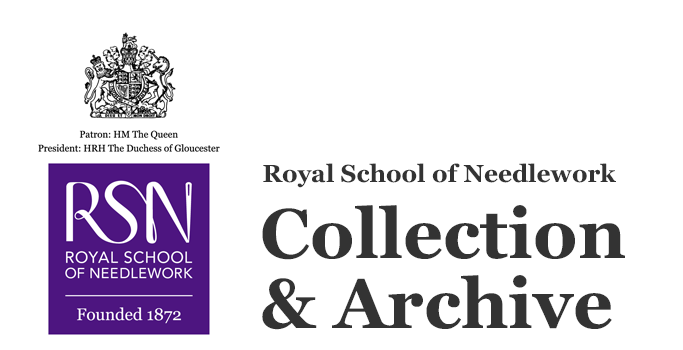Tablecloth
Object name
Date made
1920-1970
Place made
Description
Approximately mid-20th-century cream linen tablecloth of embroidered panels checkered with needlelace, cutwork, and drawn thread panels.
Content description
Circa 1920-1970 cream linen tablecloth of embroidered panels checkered with whitework panels. Needlelace panels with 13 different motifs alternate with cutwork and drawn thread panels, panels embroidered with flowers (around the edge), and panels embroidered with fruits and nuts (in the centre). The panels embroidered with flowers, fruits, and nuts are done in wool entirely in stem and chain stitches and have a narrow hem stitch (drawn thread) border.
While the arrangement of the flower panels on the outside, the cutwork and drawn thread panels on the next level inwards, and the fruit and nut panels towards the centre of the tablecloth seems planned, the needlelace panels have not been as regularly distributed. The needlelace is a kind of filet lace made of knotted mesh with darned motifs. These squares involve buttonhole bars and variations on wrapped bars. The cutwork and drawn thread panels involve hem stitch (drawn thread), double twist stitch, woven wheel corners, and a cutwork and needlelace central diamond. All of the whitework panels have been made by hand.
Given the number of techniques on display in this tablecloth, it is possible that it was purchased as a kit, with perhaps the whitework panels already complete. The ink underdrawing present underneath the embroidery adds further weight to the kit theory. The panels have been assembled inexpertly with a rough whip stitch, and they do not all line up evenly.
The floral, fruit, and nut motifs include a daffodil, Virginia creeper, cistus, forget-me-not, currant, hazelnut, orange, cherry, currant, plum, wallflower, blackberry, almond, raspberry, pomegranate, strawberry, mulberry, apple, fuchsia, narcissus, hesperantha, chamomile, and several unidentified flowers.
While the arrangement of the flower panels on the outside, the cutwork and drawn thread panels on the next level inwards, and the fruit and nut panels towards the centre of the tablecloth seems planned, the needlelace panels have not been as regularly distributed. The needlelace is a kind of filet lace made of knotted mesh with darned motifs. These squares involve buttonhole bars and variations on wrapped bars. The cutwork and drawn thread panels involve hem stitch (drawn thread), double twist stitch, woven wheel corners, and a cutwork and needlelace central diamond. All of the whitework panels have been made by hand.
Given the number of techniques on display in this tablecloth, it is possible that it was purchased as a kit, with perhaps the whitework panels already complete. The ink underdrawing present underneath the embroidery adds further weight to the kit theory. The panels have been assembled inexpertly with a rough whip stitch, and they do not all line up evenly.
The floral, fruit, and nut motifs include a daffodil, Virginia creeper, cistus, forget-me-not, currant, hazelnut, orange, cherry, currant, plum, wallflower, blackberry, almond, raspberry, pomegranate, strawberry, mulberry, apple, fuchsia, narcissus, hesperantha, chamomile, and several unidentified flowers.
Dimensions
width: 128cm
height: 128cm
height: 128cm
Materials
Stitches
Stem stitch 
Chain stitch
Buttonhole bars (cutwork)
Wrapped bars (drawn thread)
Whip stitch
Hem stitch (Drawn Thread)
Woven wheel
Double twist stitch

Chain stitch

Buttonhole bars (cutwork)

Wrapped bars (drawn thread)

Whip stitch

Hem stitch (Drawn Thread)

Woven wheel

Double twist stitch

Techniques
Motifs
daffodil
fuchsia
cherry
blackberry
raspberry
plum
strawberry
pomegranate
currant
apple
dandelion
hazelnut
Virginia creeper
cistus
forget-me-not
orange
wallflower
almond
mulberry
narcissus
hesperantha
chamomile
fuchsia
cherry
blackberry
raspberry
plum
strawberry
pomegranate
currant
apple
dandelion
hazelnut
Virginia creeper
cistus
forget-me-not
orange
wallflower
almond
mulberry
narcissus
hesperantha
chamomile
Catalogue number
COL.2018.72
Other numbers
RSN 2453
© Royal School of Needlework
